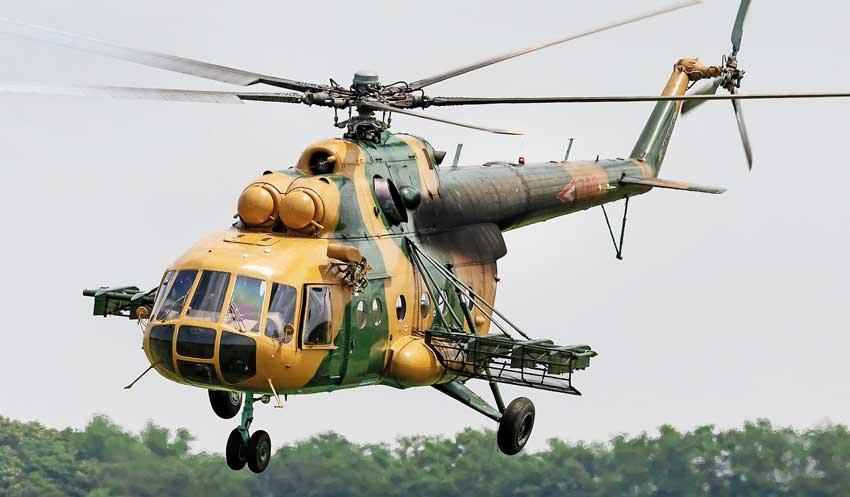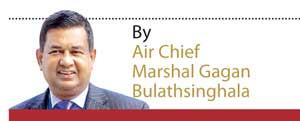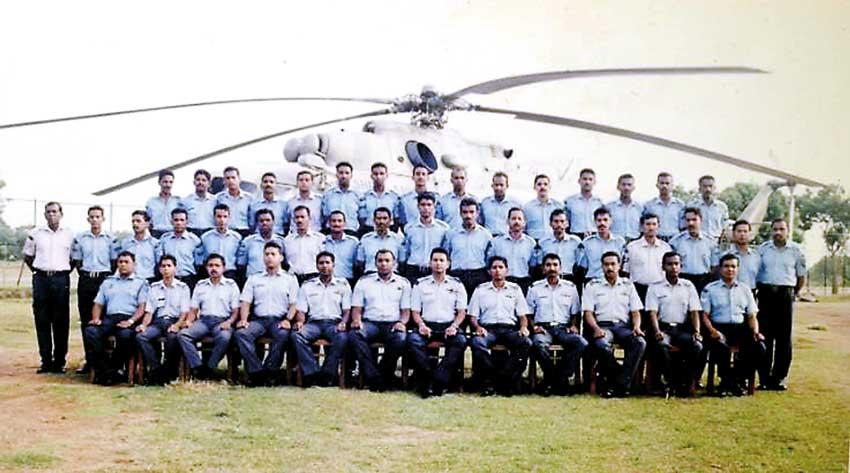Reply To:
Name - Reply Comment
Last Updated : 2024-04-30 00:00:00

 Eelam War II, the second phase of conflict between our security forces and the LTTE broke out in 1990. The conflict started with the failure of peace talks between the Government and the LTTE. The truce was broken and hostilities erupted. Then the security forces were faced with stiff restrictions on movements on the land routes due to the landmine threat posed by LTTE dominance.
Eelam War II, the second phase of conflict between our security forces and the LTTE broke out in 1990. The conflict started with the failure of peace talks between the Government and the LTTE. The truce was broken and hostilities erupted. Then the security forces were faced with stiff restrictions on movements on the land routes due to the landmine threat posed by LTTE dominance.
The situation became acute in 1992, and the satellite security force establishments became air dependent, that made a logistical nightmare for the SLAF. Further, on a survey carried to look into the welfare of the troops in the theatres of operation, it was revealed that the restriction on leave had a major impact on the morale of the troops.
At that time only the Bell 212/412 helicopters were available in the SLAF for the air supply that could carry only ten troops plus 200kgs or 900kgs of cargo at a time. This payload of the Bell 212/412s was barely adequate to cater for the deployed strength. With the intensification of the operations, the troop levels further increased.
Hence, the leave of the troops became a burning issue mainly for the Sri Lanka Army as the strength was higher. Further, it became evident to the Government that the efforts of the SLAF and capacity of the Bell 212/412s were inadequate for the task at hand. Due to this reason then SLAF Commander ACM Terrance Gunawardena was able to convince the government on the need for the induction of Heavy/Medium lift helicopters to the SLAF. The Government accepted the proposition and approved the acquisition. After a detail evaluation, it was decided that the Mi-17 was the optimally suited helicopter to be inducted to the SLAF role in supporting the operations and keeping the security forces sustained logistically.

First operational flight Gp Capt R Weerasinghe, ACM MJT De S Gunawardena, Gen Rohan Daluwatte, Air Cdre MS Sally, and the other officers
Formation
Sequel to the decision made on the induction of the Mi-17 helicopters, the process started for the formation of a squadron. It was a novel experience for the SLAF to induct the first-ever heavy-lift helicopters. It was a major quantum leap from a 5090Kgs all up weight helicopter to a 13,000Kgs all up weight helicopter.
|
CO and OCM on Landing after a Test flight in |
I was appointed as the Commanding Officer designate as a Squadron Leader until the helicopters arrived. To me, it was an actual challenge with only ten (10) years of service to raise a squadron with a new type of helicopter from scratch. But, I am proud to have been considered as a young Squadron Leader to be the founding Commanding Officer on a new platform induction that has proven its worth today.
As we did not have any experience in the operation of the heavy-lift helicopters we looked towards our neighbours for assistance.
Bangladesh and Pakistan responded immediately and offered us training and technical support for the helicopter inductions. The initial set of pilots and engineers were designated after me for the squadron and six pilots and eight engineering officers were nominated. Further, the concept of a flight engineer onboard helicopters was being experienced for the first time in the SLAF.
Pioneers
In 1993, the pioneer SLAF Mi-17 team, included Flight Lieutenant Royce Gunaratne (Retired as an Air Commodore), Flight Lieutenant Sumangala Dias the present commander, Flight Lieutenant Kapila Ratnesekara (retired as a Squadron Leader), Flight Lieutenant Priyantha Weeraman (MIA on a Mi-17 as a Wing Commander), Flight Lieutenant Tyrone Silvapulle (KIA in a Mi-24 crash as a Wing Commander) and Flight Lieutenant Kapila Wanigasuriya (AVM. Presently the Director of Welfare). The engineering team was Squadron Leader Harsha Fernando (Retired as an Air Commodore), Flight Lieutenant Priyantha Ranasinghe (Air Commodore presently the Deputy Director Aeronautical Engineering), Flight Lieutenant Ranjith Senanayake (Air Commodore. Presently the Air Secretary), Flying Officer Nalaka Athukorala (Retired as a Wing Commander), Pilot Officer Chandima Alwis, (Group Captain. Presently the Command Research and Development Officer), Pilot Officer Chandana Liyanage (Retired as a Wing Commander), Flying Officer KC Fernando (Retired as a Wing Commander) and Pilot Officer HMSB Herath (Air Commodore. Presently the Chief Procurement Officer) as the logistics officer who was on his first posting after joining the Sri Lanka Air Force.
It was heartening to see a Russian AN 124 at Katunayake and unloading the MI-17s.
I really cannot remember the exact date but, it was early March 1993. Initial induction of three helicopters was from the Kazan plant in Russia. They had the tail numbers CH 590, CH 591 and CH 592. Of these three helicopters on induction, we had only one helicopter with cockpit placards in English whilst the other two were in Russian that created a challenge when carrying out night flying which was resolved subsequently. The next lot of three helicopters were from the Ulan Ude plant in Siberia.
After the assembly, test flying and acceptance were completed in Katunayake No. 6 Helicopter Squadron was formed on 15th March 1993. The Russian ‘flying and the technical support teams’ remained in Sri Lanka to complete the training as specified by the contract.
Training Assistance
In the interim Bangladesh and Pakistan Governments responded with training and two teams were selected for the same. Flight Lieutenant Royce Gunaratne, present Commander as Flight Lieutenant Sumangala Dias, Flight Lieutenant Ranjith Senanayake and Flying Officer KC Fernando left for the Army Air Corps in Multan, Pakistan.
In Multan, they had only Mi-8s, which are similar but an older version from which the Mi-17 was developed to overcome technical challenges posed.
Though the type was not identical the team gained sufficient understanding of the operation and maintenance that was helpful in the formative stages.
The other team Flying Officer Nalaka Athukorala and self, proceeded to Zahural Haque Air Force Base Chittagong, Bangladesh. We followed a fully tailored technical course in an operational Mi-17 squadron.
The training imparted was extremely useful to us in the formation, and this training was followed by a team of BAF senior Non-Commission officers being attached to Sri Lanka for the training of our technicians for three months in the squadron.
When we moved to Anuradhapura initially on April 26, 1993, we shared the No 1 Flying Training Wing (FTW) hangar and main apron for our operations which was mostly training.
CO’s office was located at the sub-guard room at the Anuradhapura Base, across the road opposite the FTW hangar. During our absence on overseas training the late Group Captain Roger Weerasinghe, who was Squadron Leader, a qualified helicopter instructor and the Base Commander Anuradhapura at that time overlooked the training of the remaining pilots and flight engineers under the auspices of the Russian pilots and technical crew. Constraints were initially faced in training due to the language barrier however, we were able to complete the training as scheduled.
The first operational flight was carried out from Vavuniya to Elephant Pass with the then commander, ACM MJT De S Gunawardena on April 29, 1993.

Arriving at Vavuniya
As our operating destinations were north of Vavuniya it was decided that the No 6 Squadron should be located in Vavuniya. When we initially arrived in Vavuniya it was only an average size non-flying station commanded by Squadron Leader RANR (Nihal) Ratnayake. There were no buildings and infrastructure earmarked for us.
However, Squadron Leader Nihal Ratnayake was keen to support the formation of the squadron and accommodate the requirements within his station with the available facilities. My (CO) office, the orderly room and OCMs office were the only offices located in permanent buildings. We shared a room on the ground floor of the old RAF tower building next to the armoury. The OC Maintenance occupied a small office adjacent to mine in the same building with the entrance from outside. The rest of the squadron was in a temporary zinc corrugated sheet clad structure which included OC Ops, OC training, crew room, technical control and the lecture room.
The Squadron Air Sea Rescue (ASR) table was under a Kohomba tree tentage. We had three luminous orange colour Russian steel chests that we used to store our tools and other equipment. That was the humble beginning of the No. 6 Squadron.
Operational activity
Both teams who were overseas returned with a satisfactory technical knowledge that helped to a great extent for the formation of the squadron and developing flying and technical procedures. After the pilots logged sufficient hours of training the operations commenced.
Our initial destinations were Pooneryn, Elephant Pass and Mullaithivu with a limited number of twenty passengers.
The Mi-17 was a very robust helicopter with an enormous amount of power. Though all the pilots were sufficiently experienced on helicopters we needed to respect and master the flying characteristics of the heavy Mi-17. Though the induction of a new helicopter usually takes a considerable time the Mi-17 was inducted for operations in Sri Lanka on a fast track channel due to the operational urgency.
We then gradually expanded the operation to Mannar. I flew this initial flight with the Late Gp Capt Roger Weerasinghe, I can still recollect how jubilant the troops were to see the Mi-17 landing at Mannar for the first time. Immediately, after we landed we saw the troops approaching the helicopter like a swarm of bees. The late Gp Capt Roger looked at me in astonishment and we were unable to comprehend the situation.
Without any exaggeration, more than one hundred troops were fighting their way to the helicopter door to get in. Both of us felt so bad on witnessing how desperate the troops were to get home to see their loved ones. As the situation was a bit out of control the late Gp Capt Roger got off the helicopter and got the assistance of Military Police to settle in the passengers. At that point, I strongly felt that induction of the Mi-17 was indeed a long-overdue need which was finally fulfilled.
I must remark on the landing point at Pooneryn which was on the main road to the Sangupity ferry. The rest of the land surrounding the army unit gets inundated with the lagoon water on high tide and during the monsoonal seasons.
With only a white centerline marked for our landing guidance on a road with a very marginal width, it was a challenge to land especially during strong winds.
After mastering and being fully proficient on the flying behaviour of the Mi-17 the number of troops carried on board was increased from 20 to 30 passengers which immensely eased the Army’s backlog of leave. We used to fly two helicopters and meet the operational demand and rotate the third helicopter so that the maintenance was staggered without any strain on the operation. Though the number of crews was limited we were able to cater for operational demand without any issues.
Another significant event during my tenure was the first-night operation inducting troops from Mannar to the north for an urgent operational need. All three helicopters were deployed till dawn and we completed the task successfully.
The concept of Airmobile operations of the Sri Lanka Army also started during my command at Vavuniya. Training commenced with the reserve battalion that was available under the late Major General Janaka Perera and unit of Lt Col Sarath Fernando of the Gemunu Watch was to the first unit to be trained with us.
Gradual build up
The acute accommodation shortage for the squadron officers was resolved with the generosity of the Army when a bungalow that was occupied by a few senior officers was released to us. Further by this time, our officers were cautiously commuting by train to and from Vavuniya.
Also by this time, a separate hangar with office annexes was under construction on the opposite side of the control tower. I used to visit the construction site and monitor the progress with the site engineer Squadron Leader JAP Perera.
On 1st June 1994, I handed over command to Squadron Leader Ranil Gurusinghe who was trailing me on the succession of squadron command. Squadron Leader Ranil Gurusinghe subsequently ascended to the appointment of the Chief of Staff of the SLAF and the AVM rank. Though my stint was short as the CO I still enjoy the pride of being the founding CO who raised the Squadron from scratch and made a solid foundation enabling it to be where it is today.
Where we are
The No. 6 Squadron has come a long way for the last twenty-seven years and has flown over 70,000 hours, which is an enormous amount of flying hours in the aviation perspective for helicopters. This figure includes 12,500 hours being flown on UN Peace Keeping Operations.
The Mi-17 has proved to be an excellent workhorse of the rotary-wing of the SLAF. The No 6 squadron played a significant role in fighting the LTTE and supporting our security forces since its inception. Also, it has proved its mettle by conveying the heads of states and also conveying His Royal Highness Prince Charles under the strict scrutiny of the Royal Household UK, in addition to other specialized Para trooping, under-slung and firefighting operations. Being accepted for two deployments on UN Peace Keeping Operations successfully in Central Africa and South Sudan has added another feather in its cap.
Over the years’ pilots, engineers and all other tradesmen have contributed immensely in many ways for the success and furtherance of the No. 6 Squadron role. Further, the efforts of all Commanding Officers have continuously added value to the great position of the No. 6 squadron is as today.
Contributors to success
I also wish to acknowledge the diligent efforts and support extended by the former Commander ACM OM Ranasinghe who was the Chief of Staff at that time, and the other key appointment holders, the Late AVM KGA Peiris Director Operations, ACM J Weerakody who was a Wing Commander and the Zonal Commander north at that time, AVM ODNL Perera, Director Aeronautical Engineering and AVM K St E Perera Director Logistics in nurturing the formation of the No. 6 Squadron.
Future
With time the pioneers of the squadron have faded away but, I am confident that the younger generation will carry on the legacy to the future and keep the Air Force and the Sri Lankan flag flying high. The President’s Colours Award is the highest honour that can be bestowed upon any military unit of Sri Lanka.
The presentation of Colours by the Commander in Chief is an acknowledgement of the Unit’s meritorious service. While the practice of carrying the Colours into battle has stopped, the tradition of receiving, holding and parading the colours continues.
Besides, Presidential Colours is a reminder to all ranks of their loyalty and duty to their Republic, their country and their service.
The Colours are highly valued, carefully guarded and highly respected. The No. 6 Squadron has served the Nation for twenty-seven years and delivered its utmost to our nation Sri Lanka, and has been befittingly recognized, by bestowing the most prestigious Presidential Colours by His Excellency Gotabaya Rajapaksa, the Commander in Chief and the President of the Democratic Socialist Republic of Sri Lanka.
In conclusion, I pause and remember all the officers and other ranks of the squadron who shed sweat, tears and finally blood for the benefit of the squadron and paid the supreme sacrifice to protect our motherland.
Safe Flying and Happy landings to No. 6 Squadron!
The writer is a former Commander of the Sri Lanka Air Force and Sri Lankan Ambassador to Afghanistan.
Asela Friday, 09 October 2020 03:11 PM
killed your own nation and taking pride... hehe

Add comment
Comments will be edited (grammar, spelling and slang) and authorized at the discretion of Daily Mirror online. The website also has the right not to publish selected comments.
Reply To:
Name - Reply Comment
US authorities are currently reviewing the manifest of every cargo aboard MV
On March 26, a couple arriving from Thailand was arrested with 88 live animal
According to villagers from Naula-Moragolla out of 105 families 80 can afford
Is the situation in Sri Lanka so grim that locals harbour hope that they coul

26 Apr 2024